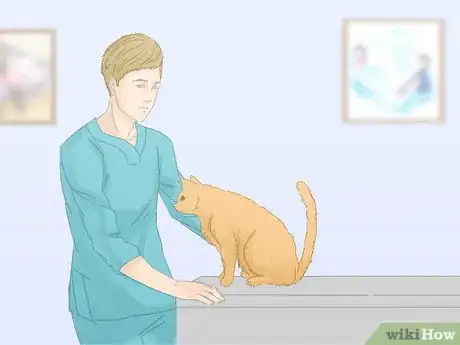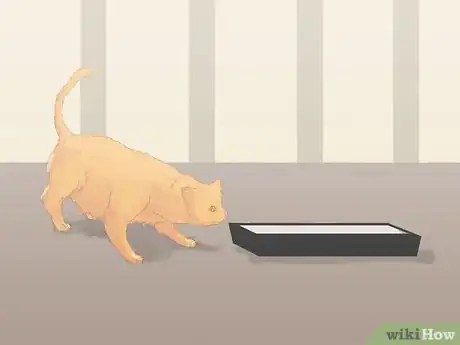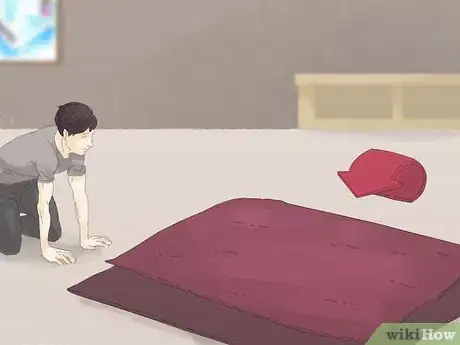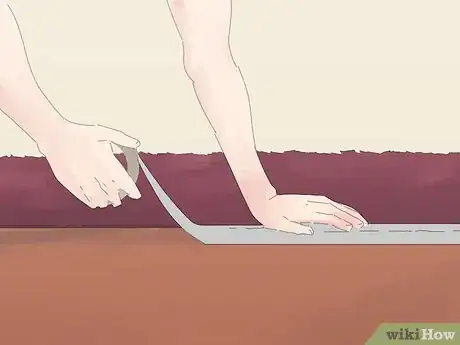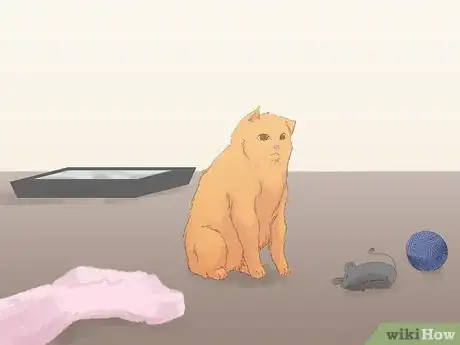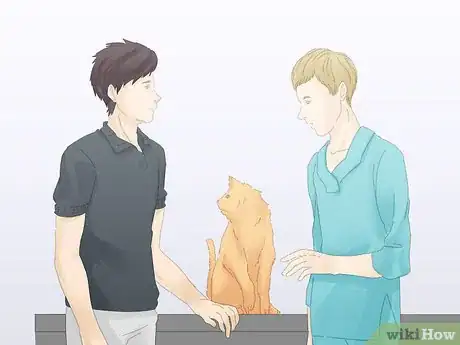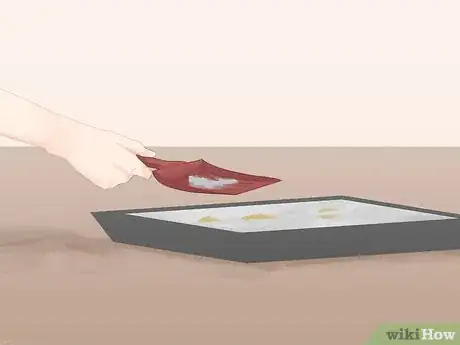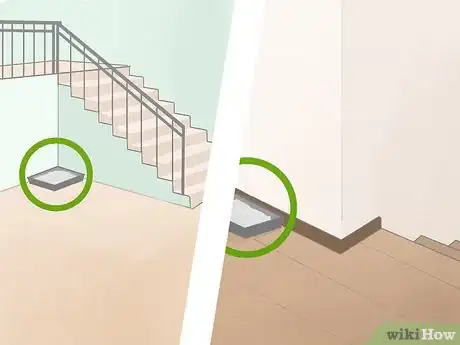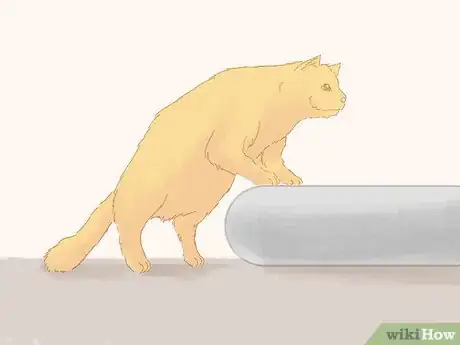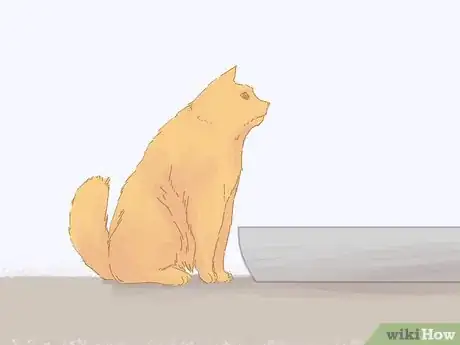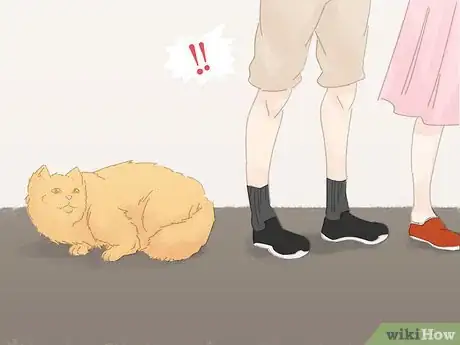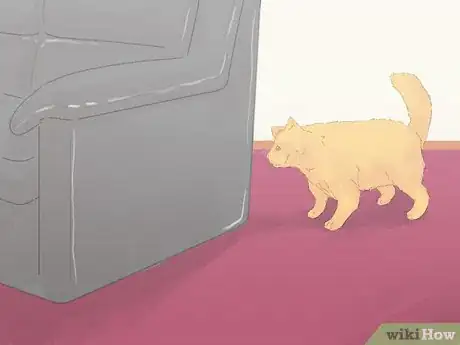This article was co-authored by Brian Bourquin, DVM. Brian Bourquin, better known as “Dr. B” to his clients, is a Veterinarian and the Owner of Boston Veterinary Clinic, a pet health care and veterinary clinic with three locations, South End/Bay Village, the Seaport, and Brookline, Massachusetts. Boston Veterinary Clinic specializes in primary veterinary care, including wellness and preventative care, sick and emergency care, soft-tissue surgery, dentistry. The clinic also provides specialty services in behavior, nutrition, and alternative pain management therapies using acupuncture, and therapeutic laser treatments. Boston Veterinary Clinic is an AAHA (American Animal Hospital Association) accredited hospital and Boston’s first Fear Free Certified Clinic. Brian has over 19 years of veterinary experience and earned his Doctor of Veterinary Medicine from Cornell University.
This article has been viewed 934,616 times.
Some cats develop a habit of urinating on carpet, which can be very frustrating for their owners. The smell of cat urine is offensive and often spreads throughout the house. Cat urine is also very hard to remove from carpet padding and fibers, which causes lingering odors. In addition, because cats have the tendency to continue to urinate on areas that already smell like urine, it is often a hard problem to correct. There are many reasons that cats urinate outside of their litter boxes, including urinary tract and bladder problems, issues with the type of litter being used and conflicts with other pets. Keep reading to learn more about how to prevent cats from urinating on carpet.
Steps
Preventing Your Cat from Urinating on the Carpet
-
1Take your cat to see a veterinarian. A medical issue, such as a urinary tract infection, may be causing your cat to urinate on the carpet instead of in a litter box. Before you try any other intervention to remedy the situation, you should take your cat to see a veterinarian to treat any medical issues that may be causing the behavior. Getting your cat checked out right away is important to protect the health and well-being of your pet and to prevent a long-lasting litter box aversion.[1]
- Squatting for long periods of time, blood in the urine, frequent urination and meowing while trying to urinate are all signs that your pet might have a bladder or urinary tract issue or infection. These health problems can cause litter box avoidance.
- Inappropriate urinations can be a medical condition and with male cats can actually be an early sign of a life-threatening blockage.[2]
-
2Clean accidents with an enzymatic cleaner. Cleaning up accidents right after they happen will also help deter your cat from using the same spot again. Use an enzymatic cleaner rather than an ammonia based one. Ammonia-based cleaners may cause your cat to urinate more often on the spot because she may interpret the ammonia as another cat’s urine that she must cover up with her own urine.[3] [4]
- Consider having your carpets cleaned professionally if they are heavily soiled.
- Some rugs may be beyond cleaning if the messes were not taken care of right away. Get rid of rugs that have been soiled repeatedly by your cat.
Advertisement -
3Place a litter box over the spot on the rug where your cat likes to urinate. If your cat has started going to the bathroom on a rug or carpet, place a litter box over that spot to encourage her to use the box instead. After she has used the box for one month, move it an inch per day until it is back where you want it to be.[5]
-
4Flip carpet runners and area rugs upside down. Cats may develop a preference for a specific rug and begin using it as a bathroom. Turning over rugs and carpet runners may discourage your cat by changing the texture of the surface. Try flipping over your rugs and carpets for a few days to see if that stops your cat from urinating on them.[6]
-
5Apply double sided sticky tape to edges of rugs. Sticky tape can discourage a cat from urinating on a rug because the sensation of the tape on its paws is unpleasant. Try applying double sided sticky tape to the edges of area rugs as well as over the spot where your cat likes to urinate.[7]
-
6Play with your cat around her box. Your cat may be urinating on the carpet because she has developed a negative association with using the litter box. Negative associations with the litter box may be improved by doing things like playing with your cat around the litter box. Try playing with your cat a few feet away from her box a few times per day to help her generate more positive feelings about the litter box.
- Do not try to reward your cat for using the litter box by giving her treats. Cats don’t like to be disturbed while they use the litter box.[8]
- You can leave treats and toys near your cat’s litter box, but do not keep your cat’s food and water dish next to her box. Cats don’t like to eat too close to where they use the bathroom.
-
7Talk to your veterinarian again if things don’t improve. Encouraging your cat to use the litter box takes time and effort, but it may not always be successful. Some veterinarians undergo special training to help people deal with problems such as urinating outside of the box. If your cat does not improve over time, consider speaking to a Certified Applied Animal Behaviorist or a board-certified veterinary behaviorist.[9]
Understanding Common Litter Box Problems
-
1Consider how often you clean the litter box. Cats do not like to use a dirty litter box and they may begin going to the bathroom elsewhere if their litter box is dirty when they need to go. If you are not cleaning your cat’s litter box every day, this may be the reason that your cat is urinating on the carpet.[10] [11]
- In addition to scooping out your cat’s litter box every day, once per week you should also remove all the litter and clean the box with warm water and unscented soap or baking soda. When you are finished, dry the box and add fresh litter.
- Try a self-cleaning litter box to make it easier to keep your cat’s litter box clean.
-
2Make sure that you have enough litter boxes in your house. It is important to have one more box than the number of cats in your household. For example, if you have three cats, then you should have four litter boxes. If you only have two litter boxes and you have three cats, then the number of litter boxes may be the reason why your cat is urinating on the carpet.[12]
-
3Determine if your cat can access the litter box with ease. If your cat has to make a long trip to get to her litter box or if the litter box itself is difficult for your cat to get into and out of, that might be the reason why your cat is urinating on the carpet. Place your cat’s litter boxes where it is easy for her to get to them in a hurry, such as one upstairs and one downstairs.[13] [14]
- Make sure that your cat will be able to see approaching humans or animals and easily get away. Cats don’t like to feel cornered
- Attend to the needs of older cats by providing boxes with lower sides, for easier entrance and exit to the litter box.
- Place litter boxes near or over where your cat tends to urinate on the carpet.
-
4Find out if the litter you use is causing the problem. Cats may avoid using the litter box because they dislike the smell or texture of the litter, or because the litter is too deep. A shallow bed of medium to fine grain clumping litter is best, but you can also try offering your cat different types of litter to see what she prefers.[15]
- Give your cat a choice of litter types by placing two litter boxes with two different types of litter right next to each other. At the end of the day, check to see which one your cat used.
- Provide a shallow bed of litter. Most cats prefer a litter box that has about 1-2 inches of litter.
-
5Determine if the style of the litter box may be causing your cat discomfort. Some cats avoid using a litter box because they don’t like the size or shape of it. Often, cats prefer open litter boxes instead of hooded ones.[16] Liners on a litter box may also be causing discomfort, so you can try removing those as well.[17]
- Consider the size of your cat’s litter box as well. If it is too small for her, then she may avoid using it.
- Cats likely feel about hooded litter boxes the same way we feel about porta potties—they're serviceable, but less than ideal.[18]
Considering Possible Health and Behavior Problems
-
1Decide if stress is causing your cat to urinate on the carpet. Other pets, children, or a noisy environment can all cause your cat to feel stressed and avoid the litter box. Make sure that your cat’s litter box is kept in a place that is semi-dark, quiet, and secluded. If your cat’s box is in a high traffic area, she will be less likely to use it.
- Try using Feliway diffusers to help your cat feel more relaxed. This product releases a scent that some cats find comforting.
-
2Consider your cat’s current or past medical conditions. Your cat’s medical history may provide an explanation for why your cat has not been using the litter box. If you suspect that your cat is sick, take her to see a vet as soon as possible. Early treatment of an illness by help stop litter box problems as well as save your cat from pain and discomfort. Urinary tract infections and feline interstitial cystitis are common conditions that may cause your cat to urinate on the carpet.[19]
- Urinary tract infections may cause a cat to avoid the litter box, even after the infection has been treated. Your cat may still associate the litter box with pain and want to avoid it.
- Feline interstitial cystitis is another common cause of litter box aversion. Cats with feline interstitial cystitis may urinate in the litter box because they feel the need to urinate more often.
- Kidney stones or a blockage of your cat’s urinary tract may also result in a litter box aversion. Your cat may meow or howl while using the box and the fear of pain may continue even after treatment.
- Keep in mind that prompt treatment of these conditions is essential so that your cat does not develop a long lasting litter box aversion.[20]
-
3Figure out if urine marking is the cause of your cat’s litter box problems. Urine marking is when your cat sprays a bit of urine on a piece of furniture or other surface to mark her territory. The amount of urine is much less than a cat will eliminate when urinating. If your cat is displaying this type of behavior, many of the suggestions in this article will be helpful, but there are additional things that you will need to do to help stop your cat from urine marking.[21]
- Urine marking is most common in unneutered male cats but unspayed female cats may also exhibit this behavior, so it is important to have your cats spayed and neutered.
- Urine marking is also common in households with more than ten cats, so keeping the number of cats in your home below ten can also help with this problem.[22]
Expert Q&A
-
QuestionSince we got a dog, the cat poops on the rug. How do we stop this?
 Pippa Elliott, MRCVSDr. Elliott, BVMS, MRCVS is a veterinarian with over 30 years of experience in veterinary surgery and companion animal practice. She graduated from the University of Glasgow in 1987 with a degree in veterinary medicine and surgery. She has worked at the same animal clinic in her hometown for over 20 years.
Pippa Elliott, MRCVSDr. Elliott, BVMS, MRCVS is a veterinarian with over 30 years of experience in veterinary surgery and companion animal practice. She graduated from the University of Glasgow in 1987 with a degree in veterinary medicine and surgery. She has worked at the same animal clinic in her hometown for over 20 years.
Veterinarian There are a couple of possibilities here. One is that the cat is 'middening' rather than toileting outside the box. This involves her pooping in certain places to mark out her territory. The other option is the cat doesn't feel secure enough in the tray to use it to poop in. Both require you to bolster the cat's security by making sure only she has access to the box, and that she can toilet in peace. Also provide cat-only rooms or areas so she feels more in control of her environment.
There are a couple of possibilities here. One is that the cat is 'middening' rather than toileting outside the box. This involves her pooping in certain places to mark out her territory. The other option is the cat doesn't feel secure enough in the tray to use it to poop in. Both require you to bolster the cat's security by making sure only she has access to the box, and that she can toilet in peace. Also provide cat-only rooms or areas so she feels more in control of her environment. -
QuestionMy cat poops in the litter box but pees on a specific spot on the carpet. I've cleaned the rug with every product possible, but still she does it. How can I get her to go back to using the tray?
 Pippa Elliott, MRCVSDr. Elliott, BVMS, MRCVS is a veterinarian with over 30 years of experience in veterinary surgery and companion animal practice. She graduated from the University of Glasgow in 1987 with a degree in veterinary medicine and surgery. She has worked at the same animal clinic in her hometown for over 20 years.
Pippa Elliott, MRCVSDr. Elliott, BVMS, MRCVS is a veterinarian with over 30 years of experience in veterinary surgery and companion animal practice. She graduated from the University of Glasgow in 1987 with a degree in veterinary medicine and surgery. She has worked at the same animal clinic in her hometown for over 20 years.
Veterinarian It might be she had a frightening experience whilst peeing in the tray and so is reluctant to use it again. For example, if the tray is located beside a washer, she may have had a shock when the washer went into spin cycle, and links fearful experience to peeing. To correct the problem take stock of where the tray is, and where it is she likes to pee. Puppy pads are a good idea, and you may even want to put a tray on the location, which you can then slowly relocate to a better place over time.
It might be she had a frightening experience whilst peeing in the tray and so is reluctant to use it again. For example, if the tray is located beside a washer, she may have had a shock when the washer went into spin cycle, and links fearful experience to peeing. To correct the problem take stock of where the tray is, and where it is she likes to pee. Puppy pads are a good idea, and you may even want to put a tray on the location, which you can then slowly relocate to a better place over time.
Warnings
- Never use ammonia or vinegar to clean carpet that your cat has urinated on. The smell is similar to cat urine, which can cause pet cats to urinate again in the same area.⧼thumbs_response⧽
- Do not use a brand of litter that has a strong smell if your cat is urinating on your carpet. Many cats are offended by strong smells and prefer cat litter that is unscented.⧼thumbs_response⧽
- Never make sudden changes to your cat's litter box or area that it is located. For example, change litter brands by mixing it with your old brand gradually. If you need to move your cat's litter box, keep one in the old area and put one in the new location until he or she uses the new one regularly.⧼thumbs_response⧽
- Do not rub your cat’s nose in the urine, pick her up and put her in the box, or confine her to a small room. These measures will not solve the problem and they may even make it worse by creating more negative associations with the litter box.[24] [25]⧼thumbs_response⧽
References
- ↑ https://www.aspca.org/pet-care/virtual-pet-behaviorist/cat-behavior/litter-box-problems
- ↑ Brian Bourquin, DVM. Cat Behavior Trainer. Expert Interview. 20 December 2019.
- ↑ https://www.aspca.org/pet-care/virtual-pet-behaviorist/cat-behavior/litter-box-problems
- ↑ http://www.humanesociety.org/animals/cats/tips/solving_litter_box_problems.html
- ↑ http://www.humanesociety.org/animals/cats/tips/solving_litter_box_problems.html
- ↑ https://www.aspca.org/pet-care/virtual-pet-behaviorist/cat-behavior/litter-box-problems
- ↑ https://www.aspca.org/pet-care/virtual-pet-behaviorist/cat-behavior/litter-box-problems
- ↑ http://pets.webmd.com/cats/guide/solving-cat-litter-box-problems?page=3
- ↑ https://www.aspca.org/pet-care/virtual-pet-behaviorist/cat-behavior/litter-box-problems
- ↑ https://www.aspca.org/pet-care/virtual-pet-behaviorist/cat-behavior/litter-box-problems
- ↑ http://pets.webmd.com/cats/guide/solving-cat-litter-box-problems?page=2
- ↑ https://www.aspca.org/pet-care/virtual-pet-behaviorist/cat-behavior/litter-box-problems
- ↑ http://pets.webmd.com/cats/guide/solving-cat-litter-box-problems?page=2
- ↑ https://www.aspca.org/pet-care/virtual-pet-behaviorist/cat-behavior/litter-box-problems
- ↑ http://pets.webmd.com/cats/guide/solving-cat-litter-box-problems?page=2
- ↑ Brian Bourquin, DVM. Cat Behavior Trainer. Expert Interview. 20 December 2019.
- ↑ https://www.aspca.org/pet-care/virtual-pet-behaviorist/cat-behavior/litter-box-problems
- ↑ Brian Bourquin, DVM. Cat Behavior Trainer. Expert Interview. 20 December 2019.
- ↑ https://www.aspca.org/pet-care/virtual-pet-behaviorist/cat-behavior/litter-box-problems
- ↑ http://www.humanesociety.org/animals/cats/tips/solving_litter_box_problems.html
- ↑ https://www.aspca.org/pet-care/virtual-pet-behaviorist/cat-behavior/litter-box-problems
- ↑ https://www.aspca.org/pet-care/virtual-pet-behaviorist/cat-behavior/urine-marking-cats
- ↑ http://pets.webmd.com/cats/guide/solving-cat-litter-box-problems?page=2
- ↑ http://pets.webmd.com/cats/guide/solving-cat-litter-box-problems?page=3
- ↑ http://www.humanesociety.org/animals/cats/tips/solving_litter_box_problems.html
About This Article
To prevent your cat from urinating on carpets, flip area rugs upside down to change their texture, which your cat may not like. Try putting double-sided sticky tape around the edges of the rug where your cat is urinating, since cats don't like that sensation, either. You can also put a litter box on the carpet where your cat likes to urinate. Then, give your cat 1 month to get used to going there before moving the litter box a little bit each day to where you want the cat using it. For more tips from our Veterinary reviewer on getting your cat to use the litter box rather than your carpets, scroll down!
